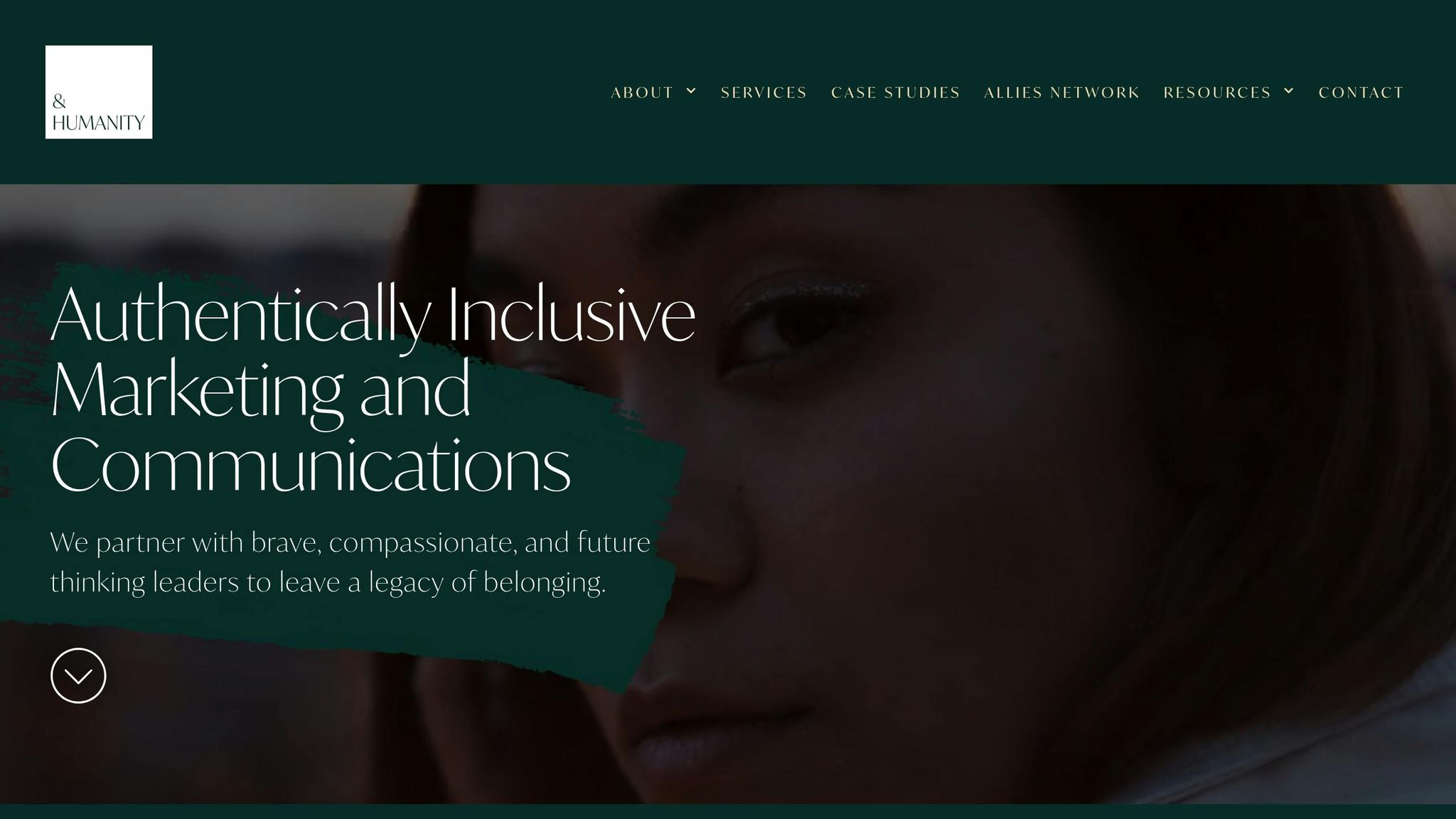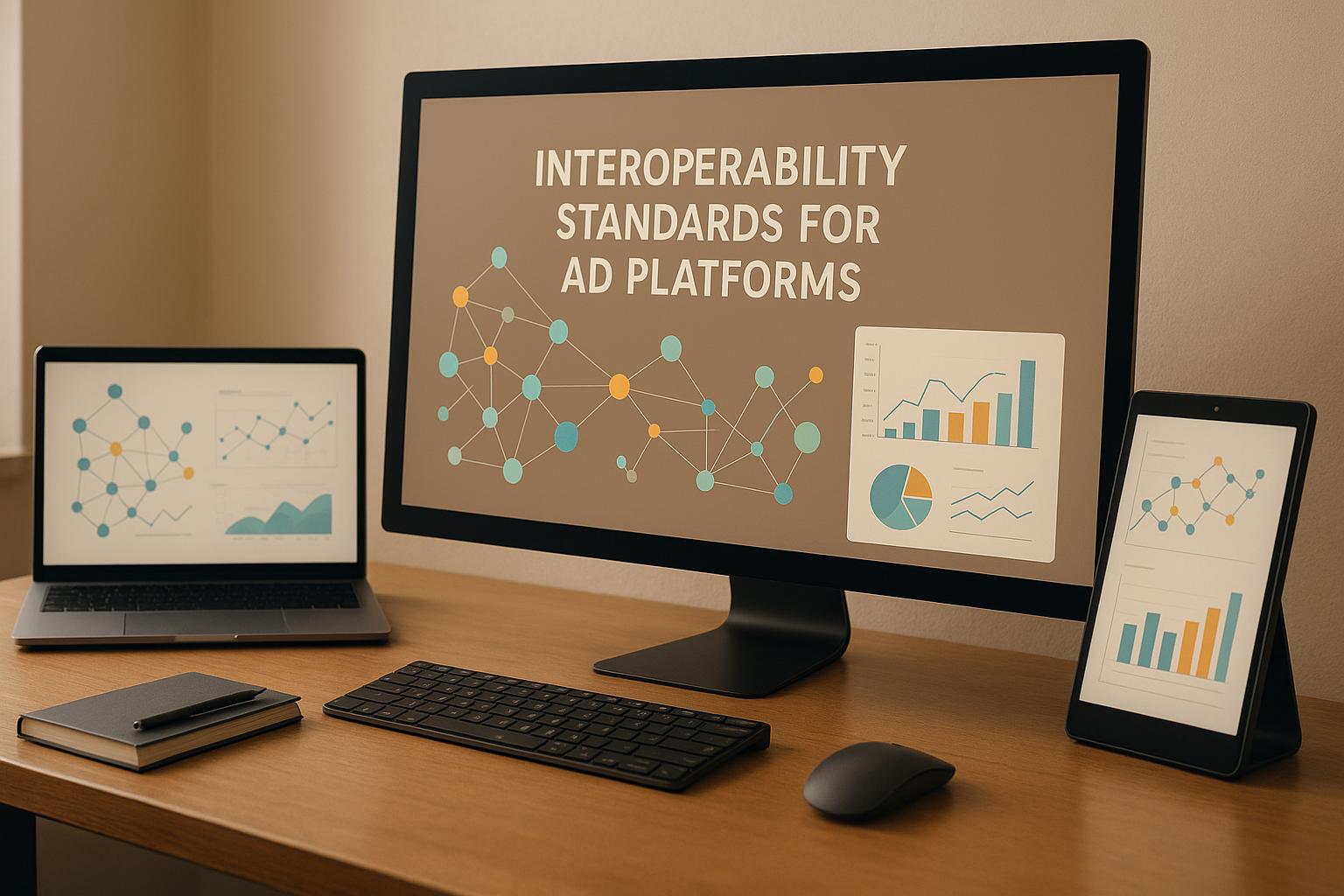Inclusive communities are reshaping media channel growth by connecting with diverse audiences and addressing gaps in representation. Here's why it matters:
- Representation Drives Engagement: 75% of consumers feel underrepresented in media, and 39% believe brands fail to reflect their communities. Addressing this gap leads to stronger connections and loyalty.
- Diversity Boosts Performance: Companies with diverse leadership are 25%-39% more likely to outperform peers in profitability and innovation.
- Audience Expectations: 81% of Gen Zers prioritize brands that reflect diversity, and 77% are willing to abandon brands that don't honor diversity commitments.
- Proven Metrics: Inclusive communities see higher content sharing (6.2x), engagement (4.5x), conversion rates (2.7x), and retention (72% over 24 months).
[Top Agency Series] Unlocking Inclusive Marketing Magic With Matthew Tsang of AndHumanity

How Diversity Drives Audience Engagement and Growth
Data clearly shows that communities embracing inclusivity consistently outperform those that don't. When media channels prioritize genuine representation, they not only foster engagement but also drive measurable business success.
Data-Driven Evidence on Diversity
Black audiences demonstrate unique media consumption patterns that highlight opportunities for meaningful brand connections. For instance, Black audiences spend 32 hours on apps and websites via smartphones and tablets, two hours more than the total U.S. population. Additionally, Black adults watch 46 hours and 13 minutes of TV weekly, compared to nearly 35 hours for the overall U.S. population.
When it comes to advertising, inclusivity pays off. 73% of Black listeners recall a brand after exposure to ads, compared to 70% overall. This shows that inclusive, targeted content doesn't just reach diverse audiences - it resonates more deeply.
In sports, Black viewership has seen remarkable growth. For example, Black audiences drove a 161% increase in viewership for the WNBA All-Star Game, a 227% rise for the WNBA Draft, and a 51% boost for the NCAA Women's Basketball Championship. This isn't just about watching - it translates into action: Black fans are 7% more likely than the average sports fan to purchase from brands involved in sponsorships.
"To win with this community who wields $2 trillion in buying power, brands must prioritize engagement strategies that center diverse Black experiences and cultural nuances." - Charlene Polite Corley, Vice President of Diverse Insights & Partnerships, Nielsen
The financial benefits of diversity extend beyond media. Companies in the top 25% for ethnic representation are 39% more likely to outperform their peers. The message is clear: diversity isn't just ethical - it’s a smart business move.
Audience Expectations for Representation
Modern audiences expect diversity from the brands they support. 81% of Gen Zers believe multicultural and diverse consumers significantly influence their brand choices. This reflects a growing demand for authentic representation in media and advertising.
This expectation isn’t superficial. 62% of LGBTQIA+ respondents want media to reflect the diversity of the real world, while 67% of Black audiences in the U.S. wish to see more representation of their identity group on TV.
The financial stakes are just as compelling. 64% of consumers back brands that sponsor multicultural events or feature diverse representation in advertising. Even more striking, 45% of consumers are willing to pay a premium for products that promote diversity, equity, and inclusion (DEI).
"Among the younger consumers who will dominate the market in the future, the deep-rooted presence and influence of multicultural and diverse people has become staggering – making intentional and authentic connection with these communities critical for any brand seeking success in the marketplace." - Mark D. Walker, CEO and Co-Founder of Direct Digital Holdings
Ignoring these expectations carries risks. 77% of respondents are prepared to abandon brands that backtrack on their diversity commitments. For brands, this means diversity isn’t just a marketing trend - it’s a long-term promise that directly impacts loyalty and growth.
Engagement Metrics: Diverse vs. Non-Diverse Communities
The advantages of inclusive communities become even clearer when looking at engagement metrics.
| Metric | Community-Driven Results | Standard Approach | Improvement Factor |
|---|---|---|---|
| Content Sharing | 6.2x more likely to share brand content | Standard social media followers | 6.2x higher |
| Comment Engagement | 4.5x higher comment rates | Traditional marketing content | 4.5x higher |
| Conversion Rates | 2.7x higher conversion | Non-community website visitors | 2.7x higher |
| Retention Rates | 72% higher over 24 months | Non-participants | 72% improvement |
| Average Order Value | 35% higher purchase values | Traditional channel acquisitions | 35% increase |
The numbers are even more compelling for publishers. Community members generate 5.3x more dwell time, are 45x more likely to subscribe, and make 3x more site visits compared to standard audiences. For those leveraging user-generated content, community members visit publisher sites 6x more often, produce 3x more page views, and spend 40x more time on-site.
These figures emphasize the power of engaged communities. In fact, one engaged community member equals the impact of 234 social media followers in terms of engagement.
Real-world examples bring these metrics to life. REFY Beauty shifted from traditional press events to hosting customers in Mallorca for a product launch. This approach generated 3.2x more social impressions than previous influencer-only campaigns and boosted conversion rates. Activewear brand Tala took a similar path by featuring all customers equally on social media, regardless of follower count. This strategy led to a 64% increase in user-generated content and a 27% rise in repeat purchases.
"Community is the way forward. It's more than a buzzword - it's a proven driver of engagement, retention and revenue." - Mark Zohar, CEO, Viafoura
These examples and metrics highlight a powerful truth: when people see themselves authentically represented, they don’t just passively consume - they engage, advocate, and contribute. This kind of engagement creates sustainable growth that benefits brands and audiences alike.
Core Components of Diverse Media Communities
Building inclusive media communities takes more than just good intentions - it requires genuine representation of diverse cultural, social, and political perspectives. This helps create "mirrors" that reflect the experiences of audiences and "windows" that offer insight into unfamiliar lives. Rosemary Truglio, Senior Vice President of Sesame Workshop, puts it well:
"Media works can be imagined either as mirrors that reflect an audience's own experience, windows that give them access to experiences they otherwise wouldn't have known, or in some cases both."
Accurate representation doesn’t just build trust; it also reduces bias and fosters loyalty. Yet, fewer than half of Canadians believe that "Canadian media is a mirror in which all Canadians can see themselves". Addressing issues like under-representation, stereotyping, and whitewashing requires more than surface-level efforts. Media content should span a wide variety of programs, genres, languages, and perspectives, while thoughtfully addressing intersections of race, gender, sexuality, and class. To achieve this, media creators should involve the communities they aim to represent, ensuring their portrayals are both respectful and accurate.
For B2B media platforms, this means showcasing diverse business leaders, highlighting companies from different backgrounds, and ensuring case studies and expert interviews reflect a broad spectrum of industry experiences. Authentic representation lays the groundwork, but empowering community participation takes inclusivity to the next level.
Community-Driven Content and Moderation
Thriving diverse communities rely on active participation in content creation and management. Crowdsourced moderation, paired with engaged moderators, helps set clear guidelines and fosters respectful dialogue. Listening to community feedback is equally important, as it can highlight gaps in moderation practices and lead to meaningful improvements. By encouraging constructive discussions, platforms ensure that all voices, including those from vulnerable or marginalized groups, are heard.
For B2B media channels, this might involve initiatives like user-generated content, moderated forums, and mentorship programs that encourage engagement across a wide audience. These efforts not only enhance inclusivity but also help build stronger connections within the community.
However, creating a diverse and inclusive space isn’t just about content - it also requires transparency and accountability.
Clear Accountability for DE&I Goals
Transparency and accountability are the cornerstones of lasting inclusion. Strong DE&I (diversity, equity, and inclusion) initiatives, supported by leadership and measurable metrics, can lead to tangible benefits like increased productivity (13.2%), innovation (8.8%), and retention (8%). Yet, only 4% of companies excel in these areas. Publicly sharing diversity goals and progress builds trust and demonstrates commitment to these values.
Take Citigroup, for example, which boosted gender diversity on its executive team from 8% to over 30% in just five years by setting and sharing clear diversity goals. Similarly, Apple saw an 87% increase in female leadership and an 80% rise in representation among underrepresented groups between 2014 and 2021. Craig Robinson, Executive Vice President and Chief Diversity Officer at NBCUniversal, emphasizes the importance of addressing systemic barriers:
"Identifying and eliminating some of the remaining systemic barriers to entry"
A well-rounded DE&I strategy should include clear timelines, assigned responsibilities, and regular evaluations. Considering that 76% of employees factor diversity, equity, and inclusion into their decision to apply for jobs, these efforts not only foster an inclusive workplace but also help attract and retain top talent.
For B2B media channels, accountability might mean publishing annual diversity reports, setting public goals for speaker diversity at events, or creating advisory boards with representatives from various backgrounds. Such transparency not only strengthens trust but also drives audience engagement and growth.
sbb-itb-01010c0
Strategies for Building Diverse Communities in B2B Media
Creating diverse communities in B2B media takes more than good intentions - it demands thoughtful, data-driven strategies. Successful leaders in this space focus on bridging representation gaps and fostering genuine engagement across a wide range of demographics and perspectives.
Audience Research and Segmentation
The foundation of any inclusive community lies in understanding your audience. Segmented campaigns generate 101% more clicks and 14% more opens than non-segmented ones, proving just how impactful this approach can be. To achieve this, develop detailed buyer personas that go beyond surface-level demographics. These personas should include information like roles, behaviors, challenges, and goals.
Segmentation for diversity requires a mix of approaches:
- Firmographic segmentation: Groups audiences by company size, industry, location, or business stage.
- Behavioral segmentation: Focuses on website activity, content downloads, and engagement trends.
- Needs and pain points segmentation: Identifies specific challenges faced by different groups and how your community can help address them.
"In B2B marketing, understanding your audience is the difference between resounding success and frustrating silence."
Adding psychographics into the mix - values, work styles, and company culture - can help uncover underrepresented groups that traditional methods might overlook. This deeper insight allows you to craft messages that resonate and build connections on a more meaningful level.
The payoff is clear: Companies using audience segmentation see a 760% increase in email revenue, and 77% of ROI comes from targeted marketing programs. For community building, this means stronger engagement, better retention, and word-of-mouth growth among diverse professional networks.
Creating Open and Diverse Spaces
Once you understand your audience, the next step is designing spaces that encourage authentic participation. Inclusive communities thrive on intentional design choices that cater to different communication styles and needs. Popular engagement channels include Slack groups, newsletters, forums, and networking events - each tailored to fit varied preferences and schedules.
A key element of inclusivity is diverse speaker selection. This involves actively seeking thought leaders from a range of industries, company sizes, regions, and backgrounds. Additionally, offering disability accommodations, translation services, and accessible venues ensures no one is left out due to physical or digital barriers.
Professional development opportunities also play a major role. Programs like mentorships, workshops, and career advancement resources designed for underrepresented groups provide value beyond networking. These initiatives not only support individual growth but also strengthen bonds within the community, creating a richer, more vibrant network.
"Numbers don't lie."
To maintain an inclusive atmosphere, clear communication guidelines are essential. Codes of conduct that emphasize respect and zero tolerance for discrimination, combined with training on unconscious bias and inclusive language, help create a safe environment where everyone feels comfortable contributing.
Using Tools for Personalization and Diversity
Technology can amplify your efforts, making it easier to scale personalized experiences without losing that human touch. AI-powered tools analyze member behavior, preferences, and engagement patterns to deliver tailored recommendations for discussions, events, and networking opportunities.
The results speak for themselves: Companies excelling in omnichannel personalization retain 89% of their customers, compared to just 33% for those who don’t. For B2B communities, this means happier members and lower churn rates. Look for tools that offer features like data enrichment, automation, scalability, and robust reporting to make personalization seamless.
Content personalization takes this a step further by identifying trending topics within member segments, suggesting relevant threads, and even generating conversation starters that align with diverse professional interests. However, combining AI efficiency with human oversight ensures that these interactions remain genuine and inclusive.
"If you set your intention from the beginning, it builds a framework you can fine-tune as you go along."
Accessibility tools are another crucial component. By following Web Content Accessibility Guidelines (WCAG), offering clear navigation, and providing features like captions and transcripts for video content, communities can ensure their digital spaces are welcoming to everyone. Regular feedback from members can help identify gaps that automated tools might miss.
Finally, analytics and reporting allow community managers to track diversity metrics across various engagement channels. Insights into member demographics, participation rates, and retention patterns highlight areas for improvement, ensuring your community continues to grow in an inclusive and meaningful way.
Measuring Success: Metrics and Case Studies
Creating inclusive communities isn't just about good intentions - it requires measurable results to demonstrate impact. Successful B2B media channels rely on specific metrics to show how diversity drives growth and engagement. As we've discussed, authentic representation boosts interaction. Here, we’ll explore how tracking the right metrics connects inclusive strategies with tangible outcomes, supported by real-world examples.
Key Metrics for Community Impact
Diversity metrics provide concrete insights into progress, helping identify gaps and inform strategies that are grounded in data. Tracking metrics aligned with your objectives is essential for evaluating success.
Engagement metrics are a strong indicator of how well your inclusive efforts are working. For example, audience growth rates can reveal whether your outreach is attracting members from underrepresented groups. Similarly, engagement rates by demographic can highlight which groups are actively participating and which might need additional attention.
Retention and churn rates are especially revealing. Communities that prioritize inclusion often see lower turnover among diverse members. Metrics like member longevity, participation frequency, and leadership representation can offer a clear picture of community health.
"Data is empirical evidence that you're making progress - or not making progress - towards your DEI goals. It helps you understand your baseline, but also what's possible."
– Laura Mills, Head of Early Career Insights at Forage
The most effective organizations balance quantitative data with qualitative insights. While numbers show the trends, qualitative feedback explains the reasons behind them.
| Key Community Metrics | What It Measures |
|---|---|
| Diversity Index | Representation of different demographic groups within your community membership |
| Engagement Rate by Segment | Participation levels across member demographics |
| Retention Rate by Group | How long members from various backgrounds stay active |
| Leadership Representation | Diversity among moderators, speakers, and contributors |
| Member Resource Group Participation | Engagement in groups for underrepresented members |
Case Evidence: Impact of Diversity
Real-world examples demonstrate how these metrics translate into meaningful growth. These case studies highlight the tangible benefits of targeted diversity efforts.
Glen Eira City Council launched the "Our Priorities, Our Future" initiative, tailoring engagement activities to different demographics. They used youth-specific surveys, paper-based options for older residents and people with disabilities, and various online participation tools. The results were impressive: 1,755 survey responses, 1,773 pop-up engagement conversations, 420 participants from underrepresented groups, and 152 young people actively involved.
"We have a very diverse community in general. It is a very multicultural community. So making sure that all of those community members are able to participate in the council's decision-making process is really important to us."
– Stacey, Glen Eira City Council
Northern Beaches Council took a different approach with their Multicultural Inclusion Plan. They worked with cultural leaders to translate materials into six languages and trained these leaders to run workshops within their communities. This effort resulted in over 130 submissions, with 57% coming from people who identified as culturally and linguistically diverse.
A standout example comes from Bend Park and Recreation District, which hired Latino Outreach Specialist Kathya Avila Choquez to better connect with the Latino community. Between 2015 and 2020, they achieved a 290% increase in Latino families served, engaging over 400 families annually. They also set annual performance goals to grow Latino family participation by at least 5%.
Gong, a revenue intelligence platform, revamped its hiring process using Greenhouse's diversity-focused tools. By sourcing 60–70% of candidates from diverse backgrounds, they achieved hiring rates where 50% of new employees were women or underrepresented minorities. This diverse workforce directly improved product development and market insights.
"Inclusive engagement is core to what we do. And we believe that it's critical to successful public policy that can result in transformative change within the community, but also internally."
– Briana Wherry, Team Leader of Social Planning and Strategy at Northern Beaches Council
These examples share common themes: targeted outreach, culturally relevant communication, and dedicated resources for inclusion. Organizations that prioritize these strategies consistently see improvements in participation, engagement, and member retention.
The data backs it up: inclusive teams are 35% more productive, and diverse teams make better business decisions 87% of the time. For B2B media channels, this translates into stronger content, richer discussions, and sustainable growth. These outcomes prove that inclusive strategies are not just ethical - they’re essential for long-term success.
Conclusion: Why Diverse Communities Matter for Growth
Building inclusive communities isn’t just the right thing to do - it’s also a smart move for business. As this research shows, diversity fuels measurable growth across the metrics that matter most for media channels.
The Long-Term Payoff of Diversity
The financial benefits of embracing diversity go far beyond short-term engagement bumps. Black, Hispanic, Latinx, and LGBTQIA+ audiences collectively account for over a third of the U.S. media and entertainment market, representing a growing financial opportunity.
This trend is amplified by generational shifts. Younger audiences are more diverse than ever, and their demand for inclusive, authentic content only continues to grow. Consider this: nearly 70% of millennials and 69% of Gen Z consumers make purchasing decisions based on whether brands reflect genuine diversity and social values.
What’s more, loyalty follows representation. Gen Z and millennial consumers are 43% more loyal to inclusive brands. Similarly, 83% of consumers with disabilities report loyalty to brands that authentically represent them. The result? Diverse representation doesn’t just build customer bases - it creates fiercely loyal ones.
The numbers back this up. Companies with culturally and ethnically diverse leadership teams are 33% more likely to see above-average profits. And brands with top diversity scores achieve 69% better stock performance. For B2B media networks, this means stronger content, more vibrant discussions, and forward-thinking solutions.
Additionally, nearly 80% of founders recognize that building a community of users is vital to their business, with 28% calling it their competitive moat. Inclusive communities create a unique advantage because they foster passionate advocacy, meaningful connections, and shared experiences that competitors can’t easily replicate.
A Call to Action for B2B Leaders
The financial and loyalty benefits of diversity make the case clear: the time for action is now. Companies that prioritize diversity innovate faster and adapt more effectively to changing market needs.
Start by conducting a diversity audit of your marketing materials. Build diverse teams to ensure campaigns reflect a range of perspectives. Research shows that brands portraying diverse cultures in their advertising see a +53% increase in consumer engagement, while those that misstep face a –17% decline.
Investing in diverse approaches uncovers the true needs of your audience. Develop targeted micro-campaigns for specific groups, ensuring they’re based on genuine understanding rather than shallow assumptions.
"The messaging should be unique for each segment and address their specific needs and desires to forge deeper connections with the brand." – Andrew Deutsch, founder of the Fangled Group
Use technology to accelerate your efforts. Personalization tools, community management platforms, and data analytics can help you scale diversity and inclusion strategies effectively. Platforms like The B2B Ecosystem offer resources such as AI-driven personalization, community insights, and active networks to support your goals.
Act now, because consumers are paying attention. Fifty-seven percent value brands' long-term commitment to diversity, and 67% expect actions to align with promises. Authenticity and consistency aren’t optional - they’re the foundation for sustainable growth.
Organizations that embrace these strategies will build the inclusive communities shaping tomorrow’s media landscape. Those that hesitate risk being left behind, stuck with outdated strategies and shrinking returns. For B2B media leaders, the path to lasting growth starts with diversity - and the time to begin is today.
FAQs
What are the best ways for media channels to measure the impact of their diversity and inclusion efforts?
Media channels can gauge the success of their diversity and inclusion initiatives by examining a mix of quantitative and qualitative data. Some of the key metrics to track include workforce demographics, retention and promotion rates, pay parity, and patterns in audience engagement.
Collecting feedback is equally important. Tools like surveys or focus groups can offer a clearer picture of how inclusive practices are experienced by employees and perceived by audiences. Keeping an eye on changes in audience demographics, engagement with content, and shifts in brand loyalty over time can also shed light on how well these efforts are resonating.
How can B2B media channels create more inclusive communities to drive growth?
Building communities that embrace everyone within B2B media channels starts with promoting diversity and accessibility. This means crafting content that speaks to a variety of audiences and ensuring platforms are open and welcoming to all. Features like user-friendly interfaces and inclusive design play a big role in making everyone feel appreciated.
Another important approach is adopting long-term diversity, equity, and inclusion (DEI) policies. These policies should influence leadership decisions, shape community interactions, and guide marketing strategies to demonstrate a genuine commitment to inclusivity. Aligning community values with diverse viewpoints also helps build real connections and encourages active participation.
When inclusivity is a priority, B2B media channels can strengthen audience loyalty, encourage more engagement, and create opportunities for lasting growth.
Why is authentic representation in media and advertising essential for building audience trust and loyalty?
Authentic representation plays a key role in building trust, creating emotional connections, and fostering a sense of belonging among diverse audiences. When individuals see themselves portrayed accurately and respectfully in media or advertising, they’re more likely to engage with the content and feel a stronger bond with the brand behind it.
Focusing on inclusivity doesn’t just broaden a brand’s audience - it also nurtures lasting loyalty. People tend to support companies that genuinely align with their values and reflect their experiences. This commitment to meaningful representation helps brands build stronger relationships and thrive in today’s ever-evolving media landscape.


